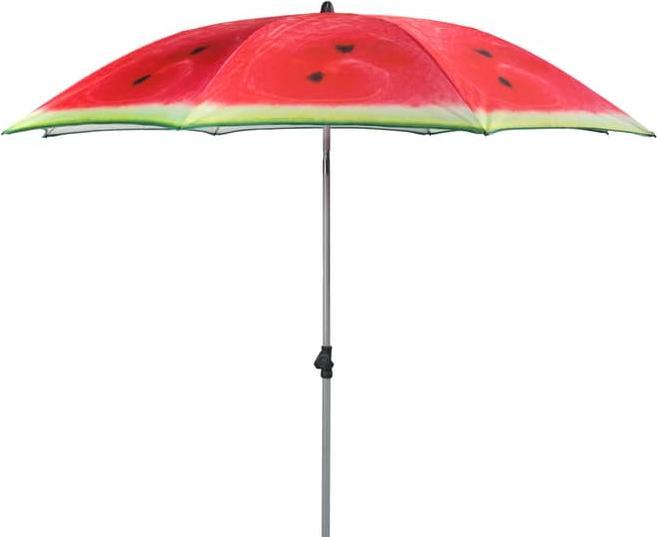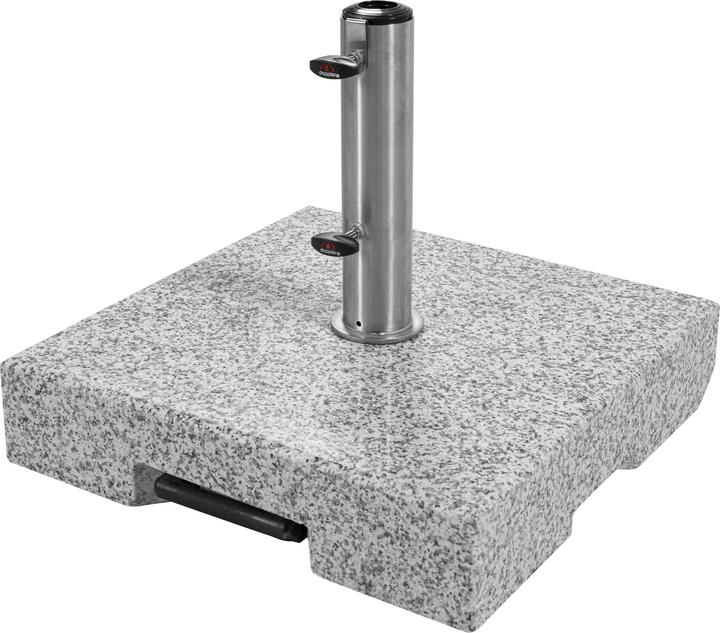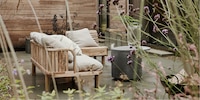

The parasols come out of the shade
With the right parasol, you can fill up on vitamin D and aspire to happiness.
Don't be fooled by the aesthetic appeal of parasols! Not all provide the same amount of shade. Before choosing between fringes or maritime patterns, the question of material is essential. The shade fabric determines the quality of protection from the sun. Size, function and appearance are secondary.
Materials and their properties
In your search for pretty designs, you need to think about two things: how much protection your skin needs and how much time you want to spend looking after the fabric. Both of these elements are linked to the material of the parasol.
UVA and UPF ratings indicate how effectively a fabric protects you from the sun's rays. A fabric with a UPF rating of 15 offers minimal protection; 30, medium; 50 and 50+, optimum. Factors that contribute to the UPF index of a fabric are, for example, the composition of the yarns or the colour: the darker the shade, the less UV light penetrates.
In order to identify quality, fabrics are tested for UV protection, light resistance and water repellency. Make sure the umbrella of your choice carries the official UPF seal, awarded by international testing centres such as Swiss Quality Testing Services, the Bundesamt für Strahlenschutz and the Arpansa. Some manufacturers such as Glatz offer an overview on their homepage that classifies each fabric used into a fabric category.
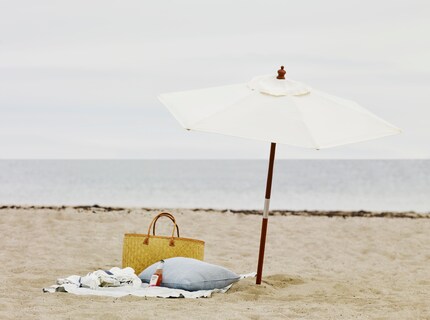
Natural materials, such as cotton and linen, are in the lowest fabric class. They only partially repel water if coated with natural or synthetic oils and do not offer high UV protection. Unlike plastics, they are not resistant to mould and require more care, as they need to be impregnated regularly. Although polyester offers better UV protection, it also belongs to the lower fabric category among plastics. After just 80 to 160 days in the sun, the colour fades. This also makes it less practical than polyacrylic, whose colour remains unaltered for two years. Olefin, on the other hand, does not change colour for two years and requires virtually no maintenance.
Parasols with artificial fabric coverings are often criticised for not being recyclable and therefore ending up in landfill. In Switzerland, parasols are classed as bulky items. Check with the manufacturer whether the parasol you have chosen can be dismantled. Brands such as Doppler or Glatz offer a wide range of accessories so you can replace a damaged cover. If something were to break on the frame, all you have to do is find the right replacement part.
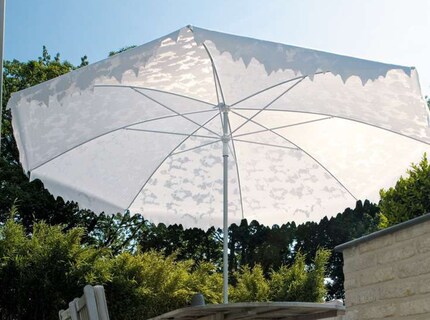
The majority of artificial sunshade coverings are made from fabric capable of allowing only 2% of UV rays through. The first forward-looking designs already exist, but they are not yet available: these are parasols that are not only made from biodegradable materials such as biopolymer, but that also play with more transparency to let in the good UV while repelling the bad.
The mast: wood or metal?
For the parasol's mast and structure, you can choose between natural or artificial materials and metals. The pole is made from teak, ash or eucalyptus, popular woods similar to those in which the garden furniture are made, as they are resistant to abrasion and water. Unlike aluminium and chromed steel, they heat up less and are distinguished by their grain. However, their colour changes over time. Coated metals and plastics are different. Depending on the coating, they are not only easier to maintain than wood, but also more resistant to fading. Aluminium and chrome-plated steel aren't immune to scratches either.
Whether natural or synthetic, every parasol needs to be protected when not in use. Think about making room in the garage or basement to preserve it over time. Most manufacturers also offer protection covers to match their models.
What shape to choose
Once you have an overview of the material, it's all about design. The space you have available will narrow down the selection, as each type of parasol can be categorised into an area of application.
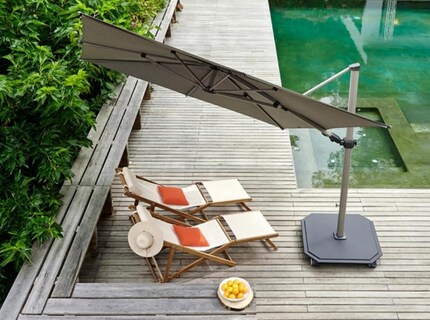
The offset parasols are suitable for large outdoor areas. As the pole is on its side, you can use the entire area below. On a balcony, it should be placed in a corner, as its support takes up a lot of space. On terraces, you have more freedom. But don't forget that an offset parasol is more unstable than its pole counterpart! It must be protected from the wind and be sufficiently weighted. Check whether a base is included in the price, otherwise you risk incurring extra costs! What's more, the flatter the offset parasol, the less rainwater will run off.
The balcony parasols are perfect for small terraces and city balconies. Mount them on the balustrade and kill two birds with one stone: the tilting models replace paravents. Follow the manufacturer's and model's instructions carefully so you can fit it safely!

A straight parasol has a pole in the middle. This makes it more stable than an offset parasol, as the weight is evenly distributed and the wind has less of an attack surface. The downside? Only part of the garden furniture is sheltered.
The shape of beach umbrellas doesn't differ from straight ones, but their weight does. For ease of transport, they are generally made of plastic, steel or aluminium. And the right cover means you can carry it wherever you like.
How to determine the size

To find out how many people can sit at the table and still benefit from the shade of the parasol, there are guide values. But if you decide to install a deckchair or garden furniture, orient yourself according to their dimensions!
| Nombre de places assises | Envergure (m) |
|---|---|
| 2 | 1,5 |
| 2-4 | 2-2,5 |
| 4-6 | 2,5-2,7 |
| 6-8 | 3 |
| 10+ | 4 |
What features should a parasol have?
To find out what functions are really needed, observe the sun's path over the course of a day! Tilting parasols can adapt to the sun and spatial conditions. Are you missing the tilt or rotation function? No problem, opt for roller underpots to move the parasol as you please!
Also think about the energy needed to use it! Sunshades with slides or clamping lever, the simplest opening variants, require more effort and are less expensive than their counterparts. They often have a span of one and a half metres. From two metres upwards, a pulley system or crank, two methods that also allow parasols over three metres to be opened without a problem. Models with electric motors are better and therefore more expensive.
When seeking protection from the sun's rays, we often forget that heat accumulates under a parasol. To avoid this problem while improving air circulation, there are so-called chimneys, air holes, in the parasol fabric. These are mainly found on the more expensive models.
What you need
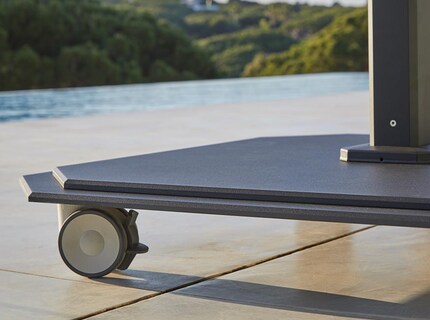
When buying, ask yourself whether you want a base or a ancrage fixe pour votre parasol ! Some parasols are available with a base, others without. The cheapest bases, made of plastic and hollow on the inside so they can be filled with sand, are suitable for beach and straight parasols with a span of one and a half metres.
For offset parasols with a reach of two metres or more, it's best to play the safety card by opting for a base made of granite and in cement that weighs at least fifty to seventy kilos. For parasols with a span of three metres or more, we recommend using up to four support panels. Again, it's best to follow the manufacturer's recommendations so that the parasol doesn't fly away in a gust of wind.
Whatever its shape, a parasol not only provides shade, but is also decorative and offers a head start over sails and other fixed awnings: it adapts to your needs and the current position of the sun.
Like a cheerleader, I love celebrating good design and bringing you closer to everything furniture- and interior design- related. I regularly curate simple yet sophisticated interior ideas, report on trends and interview creative minds about their work.
Practical solutions for everyday problems with technology, household hacks and much more.
Show all





